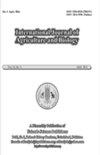Enhancing Phosphorus Bioavailability in Maize through Phosphorus Solubilizing Fungi
Q2 Agricultural and Biological Sciences
引用次数: 1
Abstract
This study was to explore the beneficial interactive effects of fungal inoculum alone or in conjunction with phosphatic fertilizer on maize (Zea mays L.). We conducted a greenhouse pot experiment in soil which included four treatments such as control, Penecillium oxalicum, Aspergiilus niger, P. oxalicum + A. niger at three different levels of phosphatic fertilizers (0, 100, and 200 mg kg-1). The plant height, fresh weight of root/shoot biomass and dry weight of root/shoot biomass and soil chemical properties were recorded. We evaluated the growth parameters of maize and phosphorus (P) uptake in maize were highest in treatment I3 × F2 (Penecillium+Aspergillus + 200 mg P kg-1) followed by I2 × F2 (Aspergillus + 200 mg P kg-1) over rest of the treatments. The beneficial effect was decreased where alone fertilizer dose was added as compared to those where it was added with the co-inoculation of phosphorus solubilizing fungi (PSF). It was observed that soil pH, total organic carbon and available P significantly changed because of various treatments. Based on these evidences, it could be inferred that increasing the maize growth by fungal culture improves soil P fertility, which is favorable to succeeding crops. Further research is needed to understand the chemistry of co-inoculation of fungal inoculum with phosphatic fertilizer. © 2022 Friends Science Publishers利用溶磷真菌提高玉米磷的生物利用度
本研究旨在探讨真菌接种物单独或与磷肥联合施用对玉米(Zea mays L.)的有益交互作用。记录了株高、根冠生物量鲜重、根冠生物质干重和土壤化学性质。我们评估了玉米的生长参数,在其余处理中,处理I3×F2(Penecillium+Aspergillus+200 mg P kg-1)的玉米对磷的吸收最高,其次是处理I2×F2(Aspergillus+200 mg P kg-1)。与与共接种溶磷真菌(PSF)相比,单独添加肥料剂量的有益效果降低。结果表明,不同处理对土壤pH值、总有机碳和有效磷均有显著影响。基于这些证据,可以推断真菌培养增加玉米生长可以提高土壤磷肥力,有利于后续作物的生长。需要进一步的研究来了解真菌接种物与磷肥共接种的化学性质。©2022 Friends Science出版社
本文章由计算机程序翻译,如有差异,请以英文原文为准。
求助全文
约1分钟内获得全文
求助全文
来源期刊

International Journal of Agriculture and Biology
AGRICULTURE, MULTIDISCIPLINARY-
CiteScore
1.70
自引率
0.00%
发文量
40
审稿时长
5 months
期刊介绍:
Information not localized
 求助内容:
求助内容: 应助结果提醒方式:
应助结果提醒方式:


